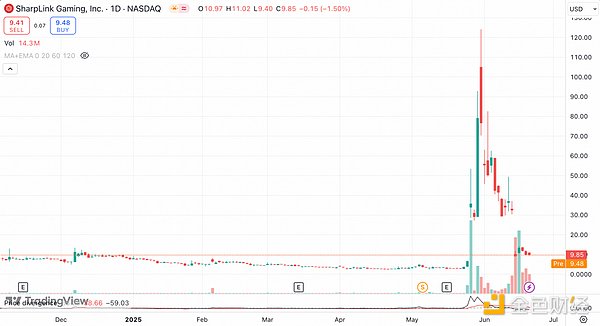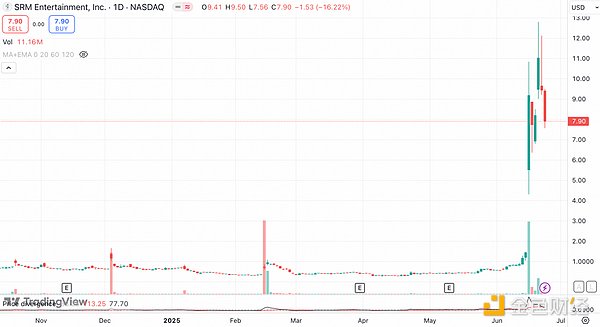Author: 0xEdwardyw, Source: TokenInsight, Compiler: Shaw Golden Finance
Abstract
The share prices of many Crypto Treasury Companies are much higher than the actual value of their crypto assets, indicating that investors may have paid too high a premium for indirect crypto exposure.
These companies are usually micro-cap stocks with extremely small circulations, and their share prices are extremely volatile and easily driven by speculative funds. Some companies may take advantage of this and temporarily push up their share prices by exaggerating their plans to purchase crypto assets, exposing retail investors to the risk of "pump-and-dump".
In the short term, such strategies do inject funds and liquidity into Altcoins, support coin prices, and bring crypto assets into traditional public capital markets. However, if the bubble bursts, if these companies collectively sell off their crypto assets, it may impact the market and trigger a large-scale decline.
Introduction
The cryptocurrency market has presented a striking paradox over the past year. Many altcoins are trading well below their all-time highs, yet a number of publicly traded companies that hold these altcoins as reserve assets have seen their share prices skyrocket.
This article will explore how the share prices of companies holding altcoins, such as Solana, Ethereum, and XRP, have surged dramatically. We will also discuss whether this phenomenon resembles a bubble, and what it means for the broader cryptocurrency market and investors.
Altcoin Markets Under Pressure, But Crypto-Related Stocks Soar
Despite a recovery in major cryptocurrencies, altcoins as a whole are still underperforming expectations in 2025. Bitcoin’s dominance has climbed to a multi-year high, while many altcoins are still trading well below their peaks. Even with a total cryptocurrency market cap of more than $3 trillion, most altcoins are still 80% to 90% below their all-time highs, suggesting that the “altcoin season” so far has been lackluster.
However, surprisingly, the share prices of some companies that hold or plan to increase their holdings of altcoins have soared far more than their corresponding crypto assets. These public companies have effectively turned themselves into cryptocurrency holding vehicles - a strategy first pioneered by MicroStrategy on Bitcoin - but now extended to various altcoins.
Here are a few notable examples of this phenomenon:

DeFi Development Corp (NASDAQ: DFDV) supports SOL
The company, formerly a real estate financing company called Janover, was acquired by a group of former Kraken executives in April 2025 and quickly entered the cryptocurrency field. The company later changed its name to DeFi Development Corp and adopted the Solana (SOL) reserve strategy, purchasing hundreds of thousands of SOL tokens.
In just over a month after announcing its Solana-centric financial plan, DeFi Dev's stock price soared by more than 1,000%, climbing from less than $4 to more than $40 at its peak.

Investors effectively viewed the stock as a proxy for Solana, pushing its price up despite overall weakness in the altcoin market. (Solana’s own price, by contrast, has fallen during this period!)
SharpLink Gaming’s (NASDAQ:SBET) ETH
Perhaps the most dramatic case is SharpLink, a sports betting and iGaming marketing company that announced plans to transform into an Ethereum holding company.
Backed by prominent crypto investors including Joseph Lubin (Ethereum co-founder and ConsenSys CEO), SharpLink raised a whopping $425 million in a private placement to purchase ETH to bolster its coffers. The market reacted enthusiastically: SharpLink’s stock price surged from less than $3 to over $100 in the week following the announcement of its Ethereum-centric strategy.

While SharpLink's stock price has subsequently fluctuated wildly, most recently plunging 70% in after-hours trading due to investors' misunderstanding of a stock registration document, its share price remains well above its pre-adjustment price. As of mid-June 2025, despite the volatility, SBET's share price is still up nearly 250% year to date, far outperforming ETH's lackluster price performance.
XRP of VivoPower International (NASDAQ: VVPR)
VivoPower is a small renewable energy company that decided to adopt XRP as its primary reserve asset in May 2025. The company announced plans to raise $121 million to acquire XRP, and has secured the backing of a Saudi prince in its private funding round.
Unlike Solana and Ethereum, VivoPower’s XRP reserve strategy led to a more muted share price reaction — shares rose about 28% to a two-year high following the news.

Nevertheless, VivoPower’s shift makes it one of the first public companies to bet on XRP as a financial asset, suggesting that even Ripple’s token, long mired in regulatory disputes, is now viewed by some businesses as a potential store of value. Company executives described the move as "growing institutional confidence in real-world blockchain applications" and said they would explore XRP-based DeFi opportunities to achieve business synergies.
Tron Inc. (NASDAQ: SRM)
SRM Entertainment is a small market company based in Florida that designs and sells licensed merchandise related to theme parks, movies, and comic book culture, such as plush toys, action figures, and collectibles sold in gift shops and specialty stores.
In June 2025, SRM announced its entry into the cryptocurrency space, launching a $210 million Tron (TRX) fund management strategy. The company raised $100 million through a PIPE transaction structured as convertible preferred stock and warrants, and received another $110 million through the exercise of warrants. The funds were provided in the form of TRX tokens rather than cash, making SRM the first US public company to hold TRX on such a large scale.
Tron founder Justin Sun joined as a strategic advisor. SRM's stock price skyrocketed more than 600% in a few days, soaring from $1.45 to over $10. The company, renamed Tron Inc., plans to stake its TRX holdings and return the staking proceeds to shareholders in the form of dividends. The move effectively provides retail investors with an equity investment opportunity to participate in the Tron ecosystem, with some analysts calling it "Tron's unofficial Nasdaq IPO."

In summary, the altcoin market is relatively sluggish, but public companies holding altcoins have experienced outsized stock price gains. Retail investors hungry for high-growth opportunities appear to be flocking to these crypto asset stocks, seeing them as another way to take advantage of the potential upside in cryptocurrencies.
Bubble Concerns and Their Impact on Crypto Markets
The stunning surge in crypto treasury strategy stocks echoes past speculative manias. Market analysts and industry veterans are increasingly debating whether these stocks are indicative of a bubble in the making. Here are several red flags that portend bubble-like dynamics:
High Valuations vs. Assets
As mentioned above, many of these companies are trading at a significant premium to the value of their cryptocurrency holdings. For every $1 of Solana or Ethereum on their balance sheets, there is a market cap equivalent to $4 or $8, meaning investors are expecting massive value creation in the future — or are simply getting caught up in the frenzy.
This “P/E to NAV” distortion is reminiscent of the Grayscale Bitcoin Trust (GBTC) premium that prevailed in 2020-21, which eventually morphed into a deep discount, with painful consequences. Retail investors in these stocks are effectively buying cryptocurrency exposure at a premium, a practice that is unlikely to last.
Micro-cap hype and pump-and-dump risk
The small size of these companies amplifies the rapid surge in share prices. Before crypto bonds made them famous, they were mostly micro-cap or penny-cap companies. This makes them vulnerable to extreme volatility and potential manipulation.
Low float (a small number of shares available for trading) can trigger explosive price moves, such as the 20x rally driven by SharpLink's 2 million float. SharpLink issued 69 million new shares through a PIPE to fund its Ethereum funding strategy. However, these new shares were almost all initially restricted and required to register with the U.S. Securities and Exchange Commission (SEC) to trade.
In addition, some operators may be taking advantage of the hype. Some unknown companies have announced ambitious cryptocurrency acquisitions that are far beyond their means, just to enjoy the "short-lived" price increase caused by "headline news."
When a small company with no credible backers claims it will buy $500 million worth of cryptocurrency, it is likely just attracting speculators to buy its shares. Retail investors need to be extra cautious to avoid falling into a trap in this situation.
Leverage and Financial Engineering
There are also concerns that these companies are actually introducing hidden leverage to the crypto ecosystem.
These companies use debt or equity financing to buy cryptocurrencies, which is exactly the same as how GBTC trades: investors use leverage to extract a premium - and when the premium disappears, such transactions end up in forced liquidation. If cryptocurrency prices fall or the premium of the shares shrinks, these companies may face pressure to raise cash and may end up selling their cryptocurrency reserves at the worst possible time.
Impact on the Crypto Market
The rise of altcoin vault company stocks will bring a range of potential outcomes to the broader crypto ecosystem.
In the short term, these companies do bring new capital to the cryptocurrency market. When SharpLink raises $425 million to buy ETH, or Upexi secures $100 million to buy SOL, those funds translate into cryptocurrency purchases, potentially driving up demand and liquidity for the associated tokens.
These developments also signal a deeper integration of cryptocurrencies with traditional financial channels. The public stock markets are being used as a tool to gain exposure to cryptocurrencies, highlighting the growing acceptance of digital assets among institutional investors. If done responsibly, crypto financial strategies can further legitimize cryptocurrencies as corporate financial tools and attract more players to the ecosystem.
On the other hand, a bubble burst could have a ripple effect that spreads across the cryptocurrency market. If many of these companies end up overextending themselves and their stock prices plummet, they could be forced to liquidate their cryptocurrency holdings to pay off their debts. Large-scale, simultaneous sales of SOL, ETH, XRP, or other cryptocurrencies by companies could lead to an oversupply in the market, driving down prices.
For retail investors, this event is a vivid reminder of the risks of chasing hype. The point of the analysis is that a company's stock can diverge dramatically from its fundamentals in the short term. Buying stocks simply because they are cryptocurrencies is not the same as diversifying into cryptocurrencies; in fact, it can be more volatile and overpriced.
 Miyuki
Miyuki
 Miyuki
Miyuki Alex
Alex Alex
Alex Miyuki
Miyuki Weiliang
Weiliang Miyuki
Miyuki Anais
Anais Alex
Alex Miyuki
Miyuki Weiliang
Weiliang